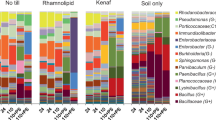Abstract
Advances in sequencing technologies have made the investigation of microbial ecology and community dynamics more tractable. The critical first step in such analyses is the efficient and representative recovery of PCR-competent DNA from complex environmental samples. All extraction protocols contain inherent biases, meaning that choice of method involves compromise between various factors, including efficiency, yield, universality, and representative extraction. Here, details are given for a routine method used in our laboratory to extract DNA from soils, sediments, biofilms, roots, and fungi.
Access this chapter
Tax calculation will be finalised at checkout
Purchases are for personal use only
Similar content being viewed by others
References
Hugenholtz P, Goebel BM, Pace NR (1998) Impact of culture-independent studies on the emerging phylogenetic view of bacterial diversity. J Bacteriol 180:4765–4774
Sogin ML et al (2006) Microbial diversity in the deep sea and the underexplored “rare biosphere”. Proc Natl Acad Sci USA 103:12115–12120
Frostegard A et al (1999) Quantification of bias related to the extraction of DNA directly from soils. Appl Environ Microbiol 65: 5409–5420
Krsek M, Wellington EMH (1999) Comparison of different methods for the isolation and purification of total community DNA from soil. J Microbiol Methods 39:1–16
Roose-Amsaleg CL, Garnier-Sillam E, Harry M (2001) Extraction and purification of microbial DNA from soil and sediment samples. Appl Soil Ecol 18:47–60
Feinstein LM, Sul WJ, Blackwood CB (2009) Assessment of bias associated with incomplete extraction of microbial DNA from soil. Appl Environ Microbiol 75:5428–5433
Inceoglu O et al (2010) Effect of DNA extraction method on the apparent microbial diversity of soil. Appl Environ Microbiol 76: 3378–3382
Martin-Laurent F et al (2001) DNA extraction from soils: old bias for new microbial diversity analysis methods. Appl Environ Microbiol 67:2354–2359
Robe P et al (2003) Extraction of DNA from soil. Eur J Soil Biol 39:183–190
Thakuria D et al (2008) Importance of DNA quality in comparative soil microbial community structure analyses. Soil Biol Biochem 40:1390–1403
Borneman J et al (1996) Molecular microbial diversity of an agricultural soil in Wisconsin. Appl Environ Microbiol 62:1935–1943
Lakay FM, Botha A, Prior BA (2007) Comparative analysis of environmental DNA extraction and purification methods from different humic acid-rich soils. J Appl Microbiol 102:265–273
Carrigg C et al (2007) DNA extraction method affects microbial community profiles from soils and sediment. Appl Microbiol Biotechnol 77:955–964
de Lipthay JR et al (2004) Impact of DNA extraction method on bacterial community composition measured by denaturing gradient gel electrophoresis. Soil Biol Biochem 36: 1607–1614
Luna GM, Dell’Anno A, Danovaro R (2006) DNA extraction procedure: a critical issue for bacterial diversity assessment in marine sediments. Environ Microbiol 8:308–320
Bürgmann H et al (2001) A strategy for optimizing quality and quantity of DNA extracted from soil. J Microbiol Methods 45:7–20
Petric I et al (2011) Inter-laboratory evaluation of the ISO standard 11063 “Soil quality—method to directly extract DNA from soil samples”. J Microbiol Methods 84:454–460
Yeates C, Gillings MR (1998) Rapid purification of DNA from soil for molecular biodiversity analysis. Lett Appl Microbiol 27:49–53
Green JL et al (2004) Spatial scaling of microbial eukaryote diversity. Nature 432: 747–750
Stow A et al (2010) Differential antimicrobial activity in response to the entomopathogenic fungus Cordyceps in six Australian bee species. Aust J Entomol 49:145–149
Gillings MR, Holley MP, Selleck M (2006) Molecular identification of species comprising an unusual biofilm from a groundwater treatment plant. Biofilms 3:19–24
Holmes AJ et al (2001) Phylogenetic structure of unusual aquatic microbial formations in Nullarbor caves, Australia. Environ Microbiol 3:256–264
Wilson GS et al (2010) Heterogeneity of surface attached microbial communities from Sydney Harbour, Australia. Marine Genomics 3:99–105
Gillings M et al (2008) The evolution of class 1 integrons and the rise of antibiotic resistance. J Bacteriol 190:5095–5100
Gillings MR et al (2008) Recovery of diverse genes for class 1 integron-integrases from environmental DNA samples. FEMS Microbiol Lett 287:56–62
Young A et al (2006) Genetic uniformity among international isolates of Leifsonia xyli subsp. xyli, causal agent of ratoon stunting disease of sugarcane (Saccharum interspecific hybrids). Aust Plant Pathol 35:503–511
Author information
Authors and Affiliations
Editor information
Editors and Affiliations
Rights and permissions
Copyright information
© 2014 Springer Science+Business Media, LLC
About this protocol
Cite this protocol
Gillings, M.R. (2014). Rapid Extraction of PCR-Competent DNA from Recalcitrant Environmental Samples. In: Paulsen, I., Holmes, A. (eds) Environmental Microbiology. Methods in Molecular Biology, vol 1096. Humana Press, Totowa, NJ. https://doi.org/10.1007/978-1-62703-712-9_2
Download citation
DOI: https://doi.org/10.1007/978-1-62703-712-9_2
Published:
Publisher Name: Humana Press, Totowa, NJ
Print ISBN: 978-1-62703-711-2
Online ISBN: 978-1-62703-712-9
eBook Packages: Springer Protocols




